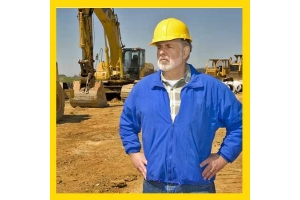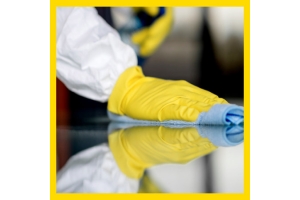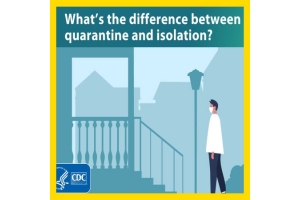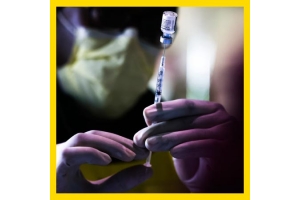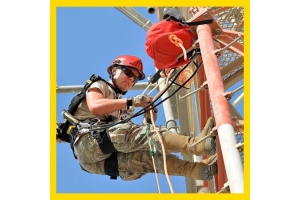Currency
-
March 30, 2019More than one-third of healthcare workers were contaminated with multi-drug resistant organisms (MDRO) after caring for patients colonized or infected with the bacteria, according to a study published today in Infection Control and Hospital Epidemiology, the journal of the Society for Healthcare Epidemiology of America. The study found that 39 percent of workers made errors in removing personal protective equipment (PPE), including gowns and gloves, increasing the incidence of contamination.
“Based on these findings, we should reevaluate strategies for removing personal protective equipment, as well as how often healthcare workers are trained on these methods,” said Koh Okamoto, MD, MS, a lead author of the study. “An intervention as simple as education about appropriate doffing of personal protective equipment may reduce healthcare worker contamination with multi-drug resistant organisms.”
Researchers at Rush University Medical Center monitored 125 healthcare workers -
March 30, 2019Even the best equipment won’t keep workers safe if they don’t know how to use it.
Falls from heights remain the biggest cause of occupational fatalities in the construction industry. According to a report by the NIOSH Fatality Assessment and Control Evaluation program, 42% of deaths between 1982 and 2015 in construction involved falls; 54% of workers killed had no access to a personal fall arrest system; and 20% of fatalities occurred in the victims’ first two months on the job.
Newest data by OSHA suggests that falls from heights will remain the leading cause of workplace fatalities in 2017/2018. As of today, 566 out of 1623 occupational deaths in the U.S. were caused by falls, which equals roughly 35% of all death causes. Not surprisingly, fall protection was the most frequently cited violation by OSHA in 2017.
These findings paint a clear picture: The risk of falling from heights is not being managed and prioritized according to its devastating effects -
March 30, 2019The first hard hat, produced by a WWI doughboy for the mining industry, came out in 1919. That inventor's great granddaughter explains how this PPE revolutionized industrial work.
-
March 30, 2019Though dropped object prevention is now recognized as a best practice, workers still need to be educated on how to eliminate risks.
-
March 23, 2019The noise thermometer shows the hazards of common occupational and off-the-job noise exposures.
Some of the most familiar sounds of season – sporting events (117 dB), rock concerts (120 dB), motorcycles (105 dB), chainsaws (118 dB), lawnmowers (94 dB) and power tools (93 dB) – can generate as much (or even more) noise than the typical workplace, where an array of regulations and hearing protection devices help workers avoid noise-induced hearing loss.
SOURCE:
https://www.ehstoday.com/safety/how-loud-can-you-go-check-noise-thermometer-infographic
-
March 23, 2019Protect yourself from the risk of falling - By Mohammed Abdul Karim
-
March 23, 2019Keep your workforce protected - By Jayandran Mohan
-
March 23, 2019As a result of The International Agency for Research on Cancer (IARC) releasing new scientific evidence that exposure to mild steel welding fume can cause lung cancer and possibly kidney cancer in humans, mild steel welding fume has been reclassified as a human carcinogen by the Workplace Health Expert Committee.
The Health and Safety Executive (HSE) has released a safety alert for those undertaking welding activities, including mild steel, in any industry. In order to protect workers, the HSE is strengthening their enforcement of cancer-causing welding fumes with immediate effect.
When SHP first published the news, it was widely shared amongst readers and, understandably, generated a fair few questions. We put your questions to the HSE:
Does the enforcement apply to just welding or mild steel cutting as well?
“The specific change in enforcement expectation approved by the Regulatory Committee applies to welding processes -
March 16, 2019Identifying firefighter hazards, response area features and potential operations helps in PPE selection
Most firefighters and officer should be informed and educated about what a risk assessment is and why it's a vital component in making emergency operations safer, more effective and more efficient. Conducting a risk assessment forces the incident commander to identify the risks to civilians and firefighters, prioritize those risks and develop an incident action plan that addresses those risks as part of the overall incident management strategy.
One of the key factors in reducing those on-scene risks to fire department personnel is personal protective equipment (PPE). But before fire department leaders select the PPE their personnel will use, they should conduct a risk assessment to ensure that the gear they select is the right gear for the job.
Why conduct a PPE risk assessment? If a fire department purchases a structural firefighting ensemble that’s -
March 16, 2019Minimising the risk of slips trips and falls
Although a common perception of health and safety legislation is that it can be excessive and onerous, it is important to remember that it exists for a very important reason – to prevent injury and loss of life. Kate Breslin, product manager at SGS, looks at the processes and procedures that should be implemented to create a safer working environment and why, when it comes to slips, trips and falls, creating an active culture of reporting and prevention should be adopted.
It is with disturbing regularity that we hear or read about accidents in the workplace that could have been prevented. Anyone who thinks that the issue of health and safety at work is overplayed should consider the fact that in the 12 months to April 2018 there were 144 people killed at work, according to the Health and Safety Executive (HSE). Furthermore, there were 71,062 injuries to employees reported under the Reporting of Injuries Diseases and Dangerous


